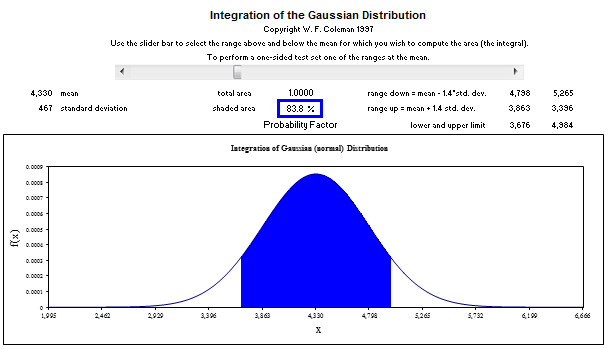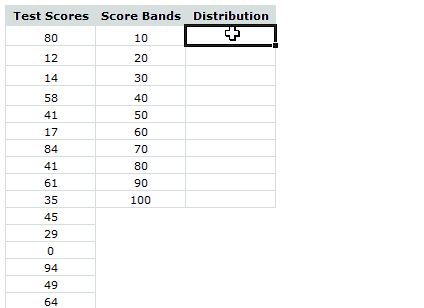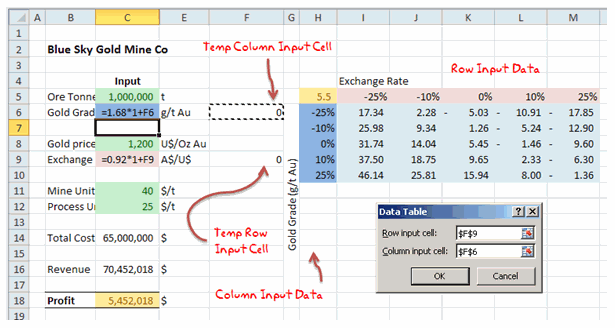One of the most dreaded courses during my under-graduation is Probability, Statistics & Queuing Theory. We called it PSQT. I struggled to understand the significance and concept of this course as I could barely concentrate in the class. We had a professor, who is probably a genius, but the moment he started the class, I would magically fall in to one of my after-noon naps. When I woke up, we are either in the middle of an elaborate t-test or going thru intricacies of a Markovian queue.
This was all 11 years ago. Later in life, I have embraced the world of probability & statistics. I still fear queues. May be I will get there one day. 😉
A good understanding of statistics & probability theory is necessary if you want to model complex real-life problems using Excel or similar tools. Naturally, Excel has several functions, features & supported add-ins to help you in this area.
Today, I want to share some of this with you. This article is broken down in to 3 parts.
- Learning Statistics & Probability using Excel
- Downloadable Excel Workbooks to understand
- Full blown models & simulations in Excel
#1 – Learning Statistics & Probability Concepts using Excel
Using Excel RAND functions
Excel has several powerful functions (formulas) to generate random numbers, random data. You can combine these functions to generate data that has certain parameters – like a give mean, standard deviation or follows a certain type of distribution.
Go thru Using Excel’s Random Functions for a detailed overview these techniques.
Simulating Dice Throws in Excel
One of the fundamental ways to learn about Probability is to look at dice throws. A dice has 6 faces and on each throw, any of the 6 faces turning up is equally likely. So, we say, each face has 1/6th probability of showing up. If you want to simulate this in Excel, you can use the formula RANDBETWEEN like this, =RANDBETWEEN(1,6). On each run, this formula would throw up a random number between 1 & 6 (including both).
For more, Simulating Dice Throws in Excel
Shuffling a List of Values in Excel
Understanding permutations and combinations is essential when it comes to modeling many real-world problems. Using Excel’s RAND, VLOOKUP and SMALL formulas we can generate a random permutation of a given list of values (in other words – we can shuffle the list).
To learn this read, Shuffling a list of values in Excel
Generate Frequency Distribution from Data
Often, when you are analyzing data, you need to understand how the data is distributed. Again, Excel has just the right function for this sort of thing. FREQUENCY(). In this simple tutorial, learn how to use Excel’s FREQUENCY formula to generate frequency distribution of given data.
Read Frequency Distributions in Excel
Trend Analysis & Forecasting using Excel
One of the most common applications of statistics is trend analysis & forecasting. Again, Excel shines with a lot of powerful formulas, built-in features and charting tools to help you understand the data & predict future based on that.
Since this is a big topic, we have covered it in 3 parts –
Part 1- Introduction to Trend Analysis & Forecasting: In this, we will learn what is trend analysis & forecasting. We will see manual forecasting technique in Excel. We will use Excel charts to depict our analysis and results.
Part 2 – Trend Analysis & Forecasting using Excel Functions
In this second part, we learn about Excel’s functions like LINEST, TREND, FORECAST, SLOPE, INTERCEPT, LOGEST and GROWTH. These powerful formulas can process lots of data and extract the trend information dynamically.
Part 3 – Trend Analysis & Forecasting using Charts & Macros
In the final part, we talk about how to use Excel chart’s trend analysis & forecasting features to estimate the trend & predict future values based on the data.
We also learn how to use Macros (VBA) to augment Excel chart’s trend-lines with useful information.
Visualizing Distribution of data with Box Plots
Box plots are an excellent way to understand the distribution of data. Unfortunately, there is no direct option to make a box plot from given data in Excel. That is where, this tutorial comes handy.
Learn how to create box plots in Excel.
#2 Downloadable Excel Workbooks
Learn Basic Statistics & Gaussian Distribution using this Excel Workbook
Glen, one of our long time readers shared this file with me. It lets you perform statistical analysis, quality control analysis, visualize Gaussian distribution based on the data you enter.
Click here to download the workbook.

Thanks Glen.
More Downloadable Workbooks
Almost all of the links in this page will take you to detailed articles on Chandoo.org, where you can also find downloadable workbook with examples. So just click thru and learn. 🙂
#3 Full blown models & simulations in Excel
A full blown model lets you learn various statistical concepts, Excel features and how to bring them all together to mimic a real-life situation.
Simulating Deal or No Deal game in Excel
In this simulation of Deal or No Deal, a popular television game, we use basic probability, permutations and Excel formulas features. You will learn how to assign random values to the suit-cases, how to use circular references, how to calculate the banker’s offer.
Simulation of Deal or No Deal game in Excel
Generating Housie / Bingo Tickets in Excel
Housie (Bingo) is a popular recreational game where the tickets contain 15 numbers between 1 to 90, arranged in 10 columns (3×10 grid). First column has numbers between 1 to 9, second column has 10 to 19 so on..
Generating a bingo ticket in Excel is a nice exercise in statistics, permutations and Excel formulas.
Learn from Bingo / Housie Tickets in Excel
Data Tables & Monte Carlo Simulations in Excel
Excel has powerful features to let us do complex simulations of real world situations. One such feature is called as data table.
The Data Table allows a set of what if questions to be posed and answered simply, and is useful in sensitivity analysis, variance analysis and even Monte Carlo (Stochastic) analysis of real life model within Excel.
The case of Blue Sky Mining Company
To help you learn about data tables, Monte Carlo simulations, we have put together a fictional mining company – Blue Sky co. and analyzed its performance under various assumptions & simulations.
To learn about this, visit Data Tables & Monte-Carlo Simulations page.
Modeling & Scheduling a FIFO (First In First Out) Queue in Excel
FIFO queues are very common in life. You can see them at Airports, coffee shops, Apple stores; Except at Airports it is FIFOUYC (FIFO Unless You are Crew).
In this article, we model & schedule a FIFO queue using Excel.
More Full Blown Models & Simulations in Excel
For more examples, check out these links.
- One more example of Data Table & Linest
- Simulating 3D dancing pendulums in Excel
- Simulating Monopoly Board Game in Excel
Do you use Statistical Concepts for your work?
As a small business owner, a good portion of my work involves statistical analysis, forecasting and simulation. I run estimates for our website traffic, revenues. I run statistical tests (split tests etc.) to optimize our sales pages, website. I estimate when my kids wake up from their nap (based on past experience) and plan my work accordingly. Thankfully, for the last part, I do not use Excel 😀
What about you? Do you use statistical concepts for your work? What are the things you use and how does Excel help you in that? What are your favorite formulas, features and tips? Please share using comments.
Special thanks to Hui & Glen
Many thanks to Hui, our resident Excel ninja for writing many of the articles on statistics, simulation, forecasting & trend analysis.
Special thanks to Glen for sharing the analyze-this file with us.
Say thanks to them if you enjoyed this.



























15 Responses to “Highlight Employees by Performance Rating – Conditional Formatting Challenge”
While this might solve the question Shelly asked, there is another option that might be more useful - a pivot table could make a list of people who fall into the various categories, so, if you needed to simply see who got in the top bracket to give them a bonus, you would have that list
Simply sorting by the rankings would work too, but you would knock them out of alphabetical order.
Normal
0
false
false
false
EN-US
X-NONE
X-NONE
/* Style Definitions */
table.MsoNormalTable
{mso-style-name:"Table Normal";
mso-tstyle-rowband-size:0;
mso-tstyle-colband-size:0;
mso-style-noshow:yes;
mso-style-priority:99;
mso-style-parent:"";
mso-padding-alt:0in 5.4pt 0in 5.4pt;
mso-para-margin-top:0in;
mso-para-margin-right:0in;
mso-para-margin-bottom:10.0pt;
mso-para-margin-left:0in;
line-height:115%;
mso-pagination:widow-orphan;
font-size:11.0pt;
font-family:"Calibri","sans-serif";
mso-ascii-font-family:Calibri;
mso-ascii-theme-font:minor-latin;
mso-hansi-font-family:Calibri;
mso-hansi-theme-font:minor-latin;
mso-bidi-font-family:"Times New Roman";
mso-bidi-theme-font:minor-bidi;}
The solution I chose makes use of the percentile formula.
The percentile formula returns the value representing the K-th percentile of a range of values. The range of values is the first criteria, and K is the second criteria in the formula.
I applied Conditional Formatting according to the formulas in the order below:
5% =$C6>=PERCENTILE($C$6:$C$33,0.95) Dark Blue
15% =$C6>=PERCENTILE($C$6:$C$33,0.85) Light Blue
65% =$C6>=PERCENTILE($C$6:$C$33,0.1) Green
10% =$C6>=PERCENTILE($C$6:$C$33,0.05) Light Red
5% =$C6<PERCENTILE($C$6:$C$33,0.05) Dark Red
The issue I noted with this approach is that Zambi was not highlighted in my solution as it is in the solution provided. Unless I am mistaken, and I very well may be, the 10th percentile for this data set is at 2.21, so Zambi would fall above the 10th percentile with a PR of 2.3.
The first step to this was figuring out the 'buckets'; what scores should fall into each range. In attempting to match the formatting of the spreadsheet, I determined the buckets below.
5% = 95% to 100%
10% = 90% up to but not including 95%
65% = 10% up to but not including 90%
10% = 5% up to but not including 10%
5% = under 5%
After that, it is a relatively simple matter to plug the necessary values into the conditional formatting formulas as shown above.
One final consideration is that while the buckets above match the color banding on the spreadsheet, I believe that the original request suggests a different color banding with 6 buckets shown below.
Top 5% = 95 to 100% Dark blue
Top 10% = 85 up to but not including 95% Light blue
Top 65% = 35 up to but not including 85% Green
Bottom 10% = 10% down to but not including 5% Light Red
Bottom 5% = 5% or under Dark Red
This leaves one final bucket of 10 to 35% (exclusive of both values) that is not highlighted and so would remain white.
Thank you Chandoo and Shelly for an interesting and useful exercise. This is certainly a valuable technique to have in my reporting bag of tricks.
Use of PERCENTILE is a smarter way of doing it. Below is my solution.
First 5 % = Apply conditional formatting (Dark Blue) as highlight ">=" =PERCENTILE(C:C,0.95)
Next 15% = Apply conditional formatting (Lighter Blue) as highlight between =PERCENTILE(C:C,0.95)-0.01 and =PERCENTILE(C:C,0.8)
Next 65% = Apply conditional formatting as highlight (Olive Green) between =PERCENTILE(C:C,0.8)-0.01 and =PERCENTILE(C:C,0.15)
Next 10% = Apply conditional formatting as highlight (Lighter Red) between =PERCENTILE(C:C,0.15)-0.01 and =PERCENTILE(C:C,0.05)
Bottom 5% = Apply conditional formatting (Red) as less than =PERCENTILE(C:C,0.05)
I agree, this is a challenge faced by HR managers every year and use of percentile formulae is the most popular solution which permits further processing like making bell curve, applying increments based on segmentation etc.
Hi Chandoo,
I came at the same solution as yours (not looking at yours first) but I have hard coded the conditions in the conditional formatting. For example:
=AND($C6>=$D$10,$C6<$D$9)
I have done the same thing 5 times for each condition. This makes the formatting independent of the order of specification. I think it will work better across versions of excel.
To copy the same thing in all sheets, Shelly can copy these formatted cells with format painter and apply it to the relevant cells in next sheet and so on! I know 700 sheets will be difficult but I dont know of any other way to apply conditional formating rules to the whole sheet.
First i have used percentile formula in the next column of "percentile Threshold" where E5, E6.. is input to colour code.
The idea behind doing this is to replicate the formula for any range and any threshold
=PERCENTILE($C$3:$C$30,1-E5)
=PERCENTILE($C$3:$C$30,1-E6)
=PERCENTILE($C$3:$C$30,1-E7)
=PERCENTILE($C$3:$C$30,1-E8)
=PERCENTILE($C$3:$C$30,1-E9)
Now i have given logic to different employee by applying "if Formula"
=+IF(J3>=$G$5,1,IF(J3>=$G$6,2,IF(J3>=$G$7,3,IF(J3>=$G$8,4,5))))
where 'J" referes to PR and "G" refers to percentile derived from above mentioned formula.
once again it is replicable (just change reference points)
Now comes the major part of Conditional Formatting, i have used "use a formula to determine which cells to be formatted"
Formula =$j=5, format "required colour" Applies to "$I$3:$J$30"
plus put tick on stop if true
This solves the query, important point that this is repeatable and can be done for n number of departments
Thanks !
I had done some reading on it and in Excel 2010 a new function has been introduced, percentile.exc. Attaching a video which also talks why the old percentile function shouldn't be used as it acts erroneous at times. Might be worth a watch Chandoo,
http://www.itechtalk.com/thread10579.html
@Deepa
Quit correct.
Where ever you use statistical spreadsheet functions and are using excel 2010 you should use the new versions of the functions as MS did a lot of work to speed up and fix errors in the old functions.
Warning: If you use the new Excel 2010 statistical functions in Named Formulas most of them will crash excel so do keep that in mind.
Hello Chandoo,
When i first read the challenge file, i thought, the color that need to be applied for a given rule, also need to be picked dynamically as given in rule set. But in the solution file, i found that color is hard Coded. So in case, someone has same data, but wants different colors, he/she needs to goto manage rules and change colors.
Let me know if my understanding is correct, and if yes, can we also make the color to be applied dynamic?
Thanks
Kishore
HI I ALSO USED THE PERCENTILE FUNCTION. HOWEVER, I WENT A STEP FURTHER AND USING THE SMALL() FUNCTION I SORTED THE DATA BY PERCENTILE SO THE COLOSCHEME WOULD BE GROUPED BASED ON THE VALUE. THIS WAY IT IS BETTER AND EASIER TO VIEW.
[...] recently posted a challenge to help a reader with a [...]
Hi, i have got doubt regarding to the percentages that has been put in chandoo's spreadsheet, i cant understadn how he put directly. can some one please explain how chandoo put the percetages straight way that i stated below..
5%
15%
60%
10%
5%
I have stumbled on this post as the solution has been already given so I have taken the liberty to record a video where I show the implementation of it as well as adding a filtering feature which I hope can prove to be useful.
Thank you
http://www.xlninja.com/2012/06/28/how-to-use-excel-to-highlight-employee-performance-rating/
[...] scriu nici macar un cuvant din urmatorul articol. Astazi mi-am citit mailul si hopa challenge de la Chandoo. Cum puteam sa refuz asa ceva si m-am apucat de citit, iar dupa 5 min i-am spus sotului ca pe asta [...]
Question for Chandoo:
I came to your site late but am totally loving these challenges 🙂
I guess it all boils down to how the bins are set up.
I agree with the PERCENTILE.INC function.
pls help me understand where I am wrong.
I have determined following the bins:
bottom 5% <=2.00 (F6:F33 <=PERCENTILE(range,.05))
lower 15% (5+10) <= 2.40 (F6:F33 <=PERCENTILE(range,.15))
lower 80% (5+10+65) <=3.46 (F6:F33 <=PERCENTILE(range,.80))
lower 95% (5+10+65+15) <=4.00 (F6:F33 =PERCENTILE(range,.95))
top 5% <=4.20 (F6:F33 <=PERCENTILE(range,1.00))
I find that only Tom is highest scorer and unique top 5% achiever.
I notice that Chandoo has included Christy and Daniel in top 5% achievers. How can there be 3 people in top 5% out of a population of 28 (5% of 28 = 1.4, i.e. only one person can achieve that status)?
I tried different ways but cannot get to that distribution.
Rest of the work is simply organizing the conditional formatting rules with Stop If True box checked.
Thanks for your insights